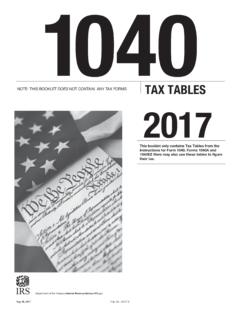Transcription of Guide to the Federal Investment Tax Credit for Commercial ...
1 Guide to the Federal Investment Tax Credit for Commercial Solar PhotovoltaicsDisclaimer: This Guide provides an overview of the Federal Investment tax Credit for those interested in Commercial solar photovoltaics, or PV. It does not constitute professional tax advice or other professional financial guidance. And it should not be used as the only source of information when making purchasing decisions, Investment decisions, or tax decisions, or when executing other binding The solar Investment tax Credit (ITC) is a tax Credit that can be claimed on Federal corporate income taxes for 30% of the cost of a solar photovoltaic (PV) system that is placed in service during the tax (Other types of renewable energy are also eligible for the ITC but are beyond the scope of this guidance.) In December 2020, Congress passed an extension of the ITC, which provides a 26% for systems commencing construction in 2020-2022, 22% for systems commencing construction in 2023, and 10% for systems commencing construction in 2024 or thereafter.
2 Any PV system placed in service after 2025, regardless of when it commenced construction, can receive a maximum tax Credit of 10%.2 Typically, a solar PV system that is eligible for the ITC can also use an accelerated depreciation corporate ProjectsTo be eligible for the business ITC (section 48 of the tax code), the solar PV system must be: Used by a business subject to Federal income taxes ( , it cannot be used by a tax-exempt entity like a charity) Located in the United States or territories (though can only be used against Federal income tax obligations)3 Systems must use new and limited previously used equipment4 Not used to generate energy for heating a swimming eligible ITC percentage scales down over time as follows: 30% tax Credit for projects commencing construction between January 1, 2006, and December 31, 2019, but placed in service before 2026 (before 2024 for projects commencing construction in 2019 and which use the IRS continuity safe harbor.)
3 See below for further detail on continuity safe harbor ). 26% tax Credit for projects commencing construction between January 1, 2020, and December 31, 2022, but placed in service before 2026 (before 2025 for projects commencing construction in 2020 and which use the IRS continuity safe harbor. See below for further detail on continuity safe harbor ). 22% tax Credit for projects commencing construction between January 1, 2023, and December 31, 2023, but placed in service before 2026. 10% tax Credit for projects commencing construction after December 31, 2023, or placed in service after December 31, solar project is considered to have commenced construction if: At least 5% of final qualifying project costs are incurred. Expenses have to be integral to generating electricity, and equipment and services have to be delivered (or delivered within months after payment). Or, physical work of significant nature is commenced on the project site or on project equipment at the factory.
4 Physical work has to be integral to the project. Preliminary activities on site ( , clearing the site or building a fence or an access road) do not count as integral. Both tests require that the project make continuous progress towards completion once construction has begun, which the Photo Credit Dennis Schroeder, NRELThe Department of Energy Solar Energy Technologies Office supports early-stage research and development to improve the affordability, reliability, and performance of solar technologies on the grid. The office invests in innovative research efforts that securely integrate more solar energy into the grid, enhance the use and storage of solar energy, and lower solar electricity considers satisfied automatically if the project is placed in service no later than four calendar years (or ten years, for projects that meet the definition of being constructed on Federal land6) after the calendar year in which construction began (these four and ten year time periods are known as continuity safe harbor ).
5 Projects can still potentially satisfy the continuity safe harbor beyond four years, depending on their individual facts and circumstances, however, because this is not guaranteed, owners may bear additional ExpensesThe ITC is calculated by multiplying the applicable tax Credit percentage (10% 30%) by the tax basis, which is the amount invested in eligible property. Eligible property includes the following: Solar PV panels, inverters, racking, balance-of-system equipment, and sales and use taxes on the equipment Installation costs and indirect costs Step-up transformers, circuit breakers, and surge arrestors Energy storage devices (if charged by a renewable energy system more than 75% of the time)8 Other Incentives and the ITCFor current information on incentives, including incentive-specific contact information, see the Database of State Incentives for Renewables and Efficiency (DSIRE) at Utility and State Government RebatesUnder most circumstances, solar PV system rebates provided by a utility or state government are considered taxable income and do not affect the tax basis when calculating the ITC.
6 For example, if the tax basis is $1,000,000 for a PV system installed at a retail business that commenced construction before December 31, 2019 and was placed in service before December 31, 2023, and the state government gives a one-time rebate of $100,000, the ITC would be calculated as * $1,000,000 = $300,0009 One exception is if the rebate is provided by a utility to a customer for purchasing or installing any energy conservation measure, including solar PV, at a When this is the case, the utility rebate is subtracted from the tax basis, reducing the amount of the ITC claimed; however, the rebate is not considered taxable income. For example, if the tax basis is $1,000,000 for a PV system installed at an apartment complex and the utility gave a one-time rebate of $100,000, and the project commenced construction before December 31, 2019 and was placed in service before December 31, 2023, the ITC would be calculated as * ($1,000,000 - $100,000) = $270,000 Other IncentivesThe following are some examples of incentives and policies associated with a solar PV system that typically do not reduce the tax basis related to the ITC (but some may be considered taxable income).
7 Revenue from the sale of renewable energy credits or other environmental attributes associated with the electricity generated by the solar PV system11 Payments for a state performance-based incentive State and local income tax credits State and local property tax exemptions on the equipment Taxable state or nonprofit grants Loan guarantees Tax-exempt and subsidized energy financing (in 2009 or after) Depreciation deductions (see below).Accelerated Depreciation and the Depreciation BonusAccelerated DepreciationA taxpayer who claims the Commercial ITC for a solar PV system placed in service can typically also take advantage of accelerated depreciation (Modified Accelerated Cost-Recovery System, or MACRS) to reduce the overall cost of a PV installation. To calculate the income on which Federal corporate taxes are owed, a business takes the difference between its revenues and expenses, plus or minus any adjustments to income. Because depreciation is considered an expense, having a larger amount to depreciate during the tax year results in a smaller overall tax liability.
8 Note that while the ITC is a tax Credit a dollar-for-dollar reduction in taxes owed depreciation is a deduction, meaning it only reduces a business s taxes by the depreciation amount multiplied by the business s tax rate (see below for an example).When the Commercial ITC12 is claimed, accelerated depreciation rules allow the full tax basis minus half the ITC to be depreciated over a five- year MACRS depreciation schedule using a half- year convention13 (where any unused depreciation can be carried forward indefinitely)14. Under the rules of this depreciation schedule, taxpayers are allowed to deduct a larger portion of this amount in earlier years, giving them the benefit of a greater immediate reduction in Federal tax DepreciationA business with a solar PV system placed in service between January 1, 2008, and September 8, 2010, or between January 1, 2012, and December 31, 2017, can elect to claim a 50% depreciation bonus. Systems placed in service between September 9, 2010 and December 31, 2011 or between January 1, 2018 and December 31, 2022, can elect to claim a 100% bonus depreciation.
9 Starting in 2023, the percentage of capital equipment that can be expensed immediately drops 20% per year ( , 80% in 2023 and 60% in 2024) until the provision drops to 0% in of a CalculationA generic example can help illustrate how each incentive could be calculated and applied at a business. Consider a business that commenced construction of a $1,000,000 solar PV system in 2023, placed it in service in 2025, and uses the calendar year as its tax year . What is the net effect of claiming the ITC, bonus depreciation, and accelerated depreciation on its 2025 tax liability?ITC CalculationAs indicated above for a solar PV property that commenced construction in 2023 and was eligible for a 22% ITC, 2when the tax basis is $1,000,000, the 22% ITC reduces tax liability by $220, Depreciation CalculationBecause the business is claiming the ITC, its depreciable basis for the system after applying the ITC is 89% (100% - 22%/2) of the tax * $1,000,000 = $890,000 To calculate the bonus depreciation for a solar PV property placed in service in 2025, the business multiplies the depreciable basis by 40% * $890,000 = $356,000 Accelerated Depreciation CalculationIn the example, the business uses accelerated depreciation to determine what amount of depreciation it will deduct in each year from 2025 to 2030.
10 Assuming this five- year recovery period, a half- year convention, and a 200% declining balance method, IRS Publication 946 Table A-1 lists the depreciation rate as 20% for year 1. The business calculates its accelerated depreciation deduction by taking the difference between the original depreciable basis and the amount claimed for the bonus depreciation and multiplying by the depreciation * ($890,000 - $356,000) = $106,800 Total Impact on Tax LiabilityAssuming the business has a Federal tax rate of 21%, the net impact of depreciation deductions is calculated * ($356,000 + $106,800) = $97,188 Therefore, the total reduced tax liability for 2023 from depreciation deductions and the ITC is:$220,000 + $97,188 = $317,188 The business will continue to claim accelerated depreciation deductions for tax years 2026, 2027, 2028, 2029, and 2030 but the specific depreciation rate will vary by Tax CreditsCarryback and Carryforward RulesUnused tax credits related to the Commercial ITC may be carried back 1 year and forward 20 years.














